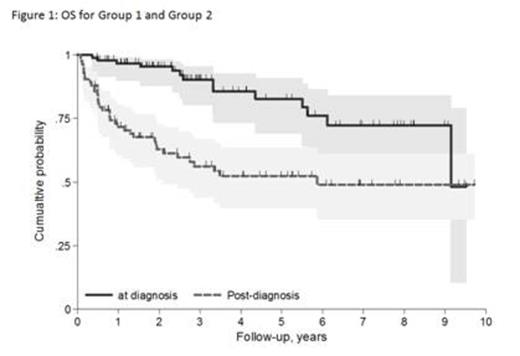Abstract
Background: Histologic transformation (HT) refers to a biologic event leading to the development of a high grade non-Hodgkin lymphoma, mostly diffuse large B cell lymphoma (DLBCL), in patients (pts) with an underlying follicular lymphoma (FL), whose recently reported risk is 2% to 3% per year. The prognosis of t-FL has been considered historically very poor, but several studies in the Rituximab (RTX) era suggest that survival may be more favorable than previously recognized.
The treatment approach for t-FL is often individualized and pts are generally excluded from clinical trials, so there is a paucity of objective data on the optimal management of t-FL, which still represents an unmet need.
The aim of our survey conducted in a large number of pts with histologically confirmed t-FL observed in 9 FIL Centers was to analyze the clinical factors and the different treatment strategies which can predict post-transformation outcome.
Methods: One hundred seventy-seven t-FL were retrospectively selected from Institutional datasets; the inclusion time frame was from 2002 to 2014. All Histologic Transformations (HT) were biopsy confirmed. Response assessment was made as recommended by International Workshop criteria. Survival analysis were performed with Kaplan-Meier method and compared by Log-Rank test.
Results: T-FL occurred at initial diagnosis (Group 1) in 93 cases (53%): 52 were DLBCL (29%) evolving from a prior FL, 31 (17%) composite lymphoma and 10 (6%) discordant lymphoma.
HT occurred after a previous FL diagnosis (Group 2) in 84 pts (47%): 15 pts (8%) were treatment-naïve at HT (Group 2A), 38 pts (21%) transformed at first relapse or progression (Group 2B) and 31 (18%) experienced late HT (Group 2C). Median age at HT was 60 years (range: 20-83).
No differences were found between Group 1 and 2 and between Group 2A, 2B and 2C in term of clinical features (age, disease stage, B-symptoms).
Group 1 received CHOP/CHOP-like regimens in 75% of pts. RTX was used with chemotherapy (CT) in 92% of pts and in 22% as maintenance. Autologous Stem Cell Transplantation (ASCT) was delivered as consolidation in 14%. Group 2 received CHOP/CHOP-like regimens in 39% of pts, platinum-containing regimens in 14%, high dose sequential therapy in 32%. RTX was added to CT in 71% of cases; 12% received RTX maintenance and 23% ASCT consolidation. CHOP as CT and RTX maintenance were used more often in Group 1 pts.
Overall Response Rate (ORR) for Group 1 was 94%, with 77 pts (83%) achieving Complete Response (CR) and 10 (11%) Partial Response (PR).With a median follow-up of 43 months, 5-yr Progression-Free Survival (PFS) and Overall Survival (OS) were 60% and 83%, respectively.
ORR for Group 2 was 57%, with 43 pts (51%) obtaining CR and 5 (6%) PR; focusing on the subgroups 2A, 2B, 2C ORR was 80%, 63% and 39%, respectively (p 0.017). The 5-yr OS was 52%, statistically inferior to Group 1 (p <0.001) (Figure 1). The use of RTX with CT and of consolidation ASCT favourably influenced survival only in group 2 but not in group 1 pts in univariate analysis.
Survival showed a significant trend (p<0.001) to progressively worsen from Group 1 to Group2c pts (Figure 2). Moreover, considering the number of previous FL treatment lines received by group 2, 5-yr OS was 58% for pts who received 1-2 lines compared to 20% for pts who received > 2 lines (p=0.004) (Figure 3).
Conclusion: Outcome of t-FL in the RTX era confirms to be better than reported in historical series and strongly differs among subgroups of pts according to the time of transformation and to the number of pre-HT treatment lines. Pts with FL transformation at lymphoma diagnosis, including composite and discordant cases, or with FL transforming after an initial watch and wait policy, i.e. treatment-naïve, show an excellent outcome with standard immuno-chemotherapy, comparable to that of FL (Federico JCO 2013) and of de novo DLBCL (Cunningham, Lancet Onc 2013). They probably do not benefit from front-line ASCT consolidation. Both ORR and survival are significantly worse in pts with t-FL diagnosed after being treated for FL. However t-FL diagnosed at first relapse/progression in this study obtained a 5-ys OS of 51%, which compares favorably with historical cohorts. On the other hand late transformation has an inferior outcome, which becomes really dismal in the sub-group of pts who transformed after two previous lines for FL, whose median survival is less than one year and clearly represent an unmet clinical need.
Rusconi:Roche: Honoraria.
Author notes
Asterisk with author names denotes non-ASH members.




This feature is available to Subscribers Only
Sign In or Create an Account Close Modal